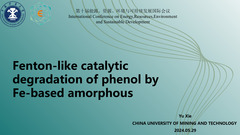[口头报告]Fenton-like catalytic degradation of phenol by Fe-based amorphous
Fenton-like catalytic degradation of phenol by Fe-based amorphous
编号:387
访问权限:仅限参会人
更新:2024-05-28 15:20:04
浏览:1979次
口头报告

报告开始:2024年05月30日 16:40 (Asia/Shanghai)
报告时间:10min
所在会议:[S7] Minerals and Advanced Energy Materials » [S7-1] Afternoon of May 30th
摘要
The organic components in coal wastewater are complex, and the natural degradation of phenolic substances is low, which has toxic effects on all plants and animals. Therefore, it is of great significance to explore the efficient degradation of phenol wastewater for the treatment of industrial wastewater and the utilization of water resources. Fe-based amorphous alloy has special structure and easy to appear catalytic center, which shows high degradation efficiency and recyclability in the process of catalytic degradation of phenol wastewater, and is an excellent catalyst. In this paper, the catalytic degradation of phenol by Fe-SiB-Cu-Nb industrial amorphous nanocrystalline bands and the effect of activation on the degradation performance of the bands were studied. The results showed that the optimal environmental conditions for strip degradation of phenol were H2O2 concentration of 60 mmol/L, temperature of 65 ℃, pH=3 and catalyst dosage of 2 g/L. In the process of degradation of phenol, selective corrosion occurs in the Fe-based amorphous alloy, and the corrosion of phenol on the strip is similar to the dissolution of Fe0. After the activation of copper sulfate, the catalytic performance rate of the strip is greatly improved, the degradation time of phenol is shortened by 20 minutes, and the degradation rate is basically the same as before activation. The improvement of catalytic degradation performance is due to the fact that the displacement reaction between a large number of Cu clusters attached to the surface of the strip after activation promotes electron transport and accelerates the galvanic effect. After 15 cycles of band reaction, activation has the effect of activating band again and accelerating the reaction rate. This study revealed part of the mechanism of degradation of phenol by Fe-based amorphous bands and the mechanism of activation on the catalytic degradation performance of Fe-based amorphous bands of phenol, which provided theoretical and experimental support for the development of Fe-based amorphous alloy catalytic materials that can degrade phenol efficiently.
关键字
报告人

发表评论